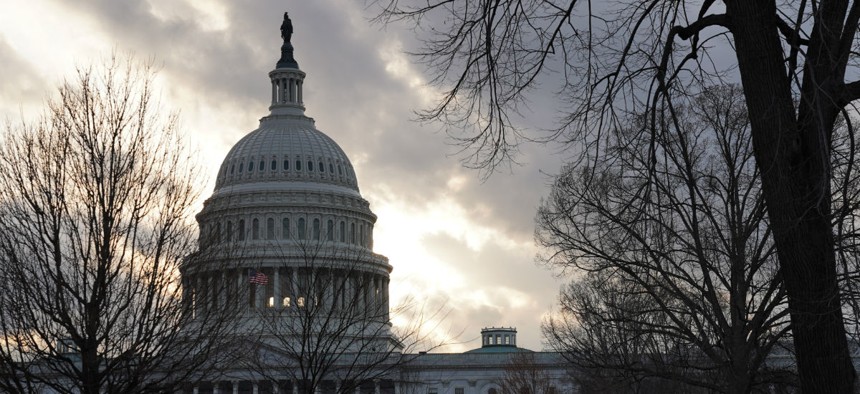
Phil Pasquini / Shutterstock.com
Another Grim Warning to Congress and Agencies: Your Fiscal Path Is 'Unsustainable'
GAO blames tax cuts and omnibus spending packages for rising debt and deficits.
In its latest blizzard of discouraging fiscal numbers, the Government Accountability Office on Wednesday weighed in with its annual plea to lawmakers and agency leaders for action to redirect the ledger-busting path on which the government has long traveled.
“The imbalance between spending and revenue that is built into current law and policy is projected to lead to continued growth of the deficit and debt held by the public as a share of [gross domestic product],” GAO wrote in its 2019 report to leaders of Congress and the president on “The Nation’s Fiscal Health.”
“This situation—in which debt grows faster than GDP—means the current federal fiscal path is unsustainable,” auditors said, echoing wording they used in last year’s edition of the same report. The latest warning—which relies on similarly alarming projections from the Congressional Budget Office—also comes two weeks after GAO issued its analysis of federal agency financial statements concluding that “much work remains to improve federal financial management and that the federal government continues to face an unsustainable long-term fiscal path.”
Some of the latest lowlights:
- In fiscal 2018, the federal budget deficit increased for the third consecutive year to $779 billion, up from $666 billion in 2017;
- Receipts increased slightly by $14 billion, 0.4 percent over fiscal 2017, a “modest increase,” GAO said, due to higher net individual income tax receipts, excise taxes, social insurance and retirement receipts, and customs duties;
- Spending increased by $127 billion, or 3.2 percent over fiscal 2017, driven by increases in defense, interest on debt held by the public, Social Security (the Old-Age and Survivors Insurance and Disability Insurance programs), Medicaid, disaster relief and flood insurance, refundable premium tax credits, and lower receipts from government-sponsored enterprises;
- Social Security spending grew because of increases both in the number of beneficiaries and in the average benefit payment;
- Total federal debt rose to $21.6 trillion during fiscal year 2018, an increase of about $1.2 trillion from fiscal 2017 (a trend that contrasts sharply with the shrinking debts of other governments of developed nations, according to the International Monetary Fund).
The key drivers are health care spending and an aging population, as well as three key laws Congress enacted, GAO said, noting that analysts at its sister agency, CBO, had projected their impact. “In its April 2018 budget and economic outlook report, CBO projected that legislation enacted from June 2017 through April 2018 increased the deficit by $242 billion for fiscal year 2018 and by $2.7 trillion over the next 10 years (2018–2027),” the new report said. “These increases were primarily due to the Tax Cuts and Jobs Act, the Bipartisan Budget Act of 2018, and the Consolidated Appropriations Act, 2018.”
A slight drop in deficits was recently visible, CBO said in its January 2019 budget and economic outlook report, due to lower projections of emergency spending such as aid to hurricane victims. “However, even with these relatively lower projections, CBO still projects that the deficit will continue to grow in the coming years,” GAO said.
Those three laws Congress passed “have complicated the government’s overall long-term fiscal outlook and debt burden,” the new report said. “Decisions in the near term to enhance economic growth and address national priorities need to be accompanied by a long-term fiscal plan to put the federal government on a sustainable long-term path.”
One additional reason for concern: “Long-term fiscal projections and GAO’s simulations show spending on net interest growing such that over the long term it becomes the largest category of spending.”
Though most responsibility for action lies with Congress and the president, “in our prior work we have identified numerous actions for executive agencies to contribute toward a sustainable fiscal future,” GAO counseled. “Although executive actions alone cannot put the U.S. government on a sustainable fiscal path, it is important for agencies to act as stewards of federal resources.”
Familiar examples include reducing improper payments (in such areas as Medicare and the earned income tax credit), reducing the “tax gap” of uncollected revenues, reducing duplication and fragmentation in agency programs, and improving “information on programs and fiscal operations.”
“To change the long-term fiscal path, policymakers will need to consider policy changes to the entire range of federal activities, both revenue and spending (entitlement programs, other mandatory spending, discretionary spending),” GAO said. “To close the gap, policymakers would need to reduce program spending, increase revenue, or, more likely, do both.”







